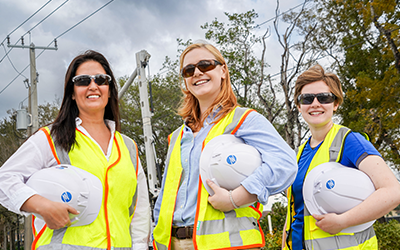
JUPITER, Fla. -- In the chaos that followed Hurricane Andrew’s devastating strike on Miami in 1992, Miguel Ochoa found himself in a community in desperate need. Back then, he didn’t work for Florida Power & Light Company (FPL), but the experience left a lasting impact on him.
“I’ll never forget. It was like a bomb went off,” Ochoa said quietly. "It’s one of the reasons why I shifted careers from being an electrician to working on the front lines of natural disasters.”
Fast forward more than 30 years, Ochoa is now a seasoned FPL lineworker, responding to dozens of Florida hurricanes and other major weather events over the last two decades.
He’s also been called on to support mutual assistance trips across the United States, from wildfires in California and several Alabama tornados to hurricanes battering coastal communities. Through it all, he’s seen firsthand the importance of helping people who lost so much to nature's fury.
“For me, it’s about going out to help those who have lost nearly everything. That’s why I go,” Ochoa said while recalling the trials of past storms, including Hurricane Ian.
He vividly remembers seeing the relief on neighbors’ faces who watched his convoy of FPL bucket trucks roll into their neighborhoods in Fort Myers. The restoration vehicles lined up in front of the power lines while lineworkers climbed and strapped into the elevated buckets with determination.
With a hydraulic hiss, the trucks extend their arms skyward, reaching toward the power lines to start the crucial work needed to illuminate homes and bring back the comforting hum of air conditioners.
“When you witness the destruction we see, then we restore power and see the happiness that follows… it’s gratifying,” said Ochoa.
At the heart of these giant machines and in the fingertips of FPL lineworkers who return a sense of normalcy to these communities is a small computer with a great responsibility.
“The technological advancements over the years have made our jobs much easier and improved reliability for our customers,” said Ochoa “We now spend less time driving around to locate the problem and are given the visibility to pinpoint exactly where we need to be.”
Responsible for equipping bucket trucks with all the hardware and software required to keep communities connected to the energy grid is Information Technology Manager Heidi Kramer and her team.
“It’s a very tough job our lineworkers have,” Kramer said while climbing into the passenger seat of a bucket truck to check its function. “By powering these intricate computer networks inside, we’re giving them the tools they need to restore power safely and as quickly as possible for our customers.”
She points to the computer in the truck’s center console where a map displays real-time data on outages and weather patterns across the county. Through this cutting-edge restoration spatial view technology, crews in the field can pinpoint trouble spots with unprecedented accuracy, streamlining the restoration process and reducing outage times for customers.
As part of FPL’s commitment to continuous improvement, the company is using lessons learned from all previous storms to continue building a stronger, smarter and more storm-resilient grid.
“When our customers, and the state, need us most, we're all in it together and that remains true this storm season,” said Ochoa.





